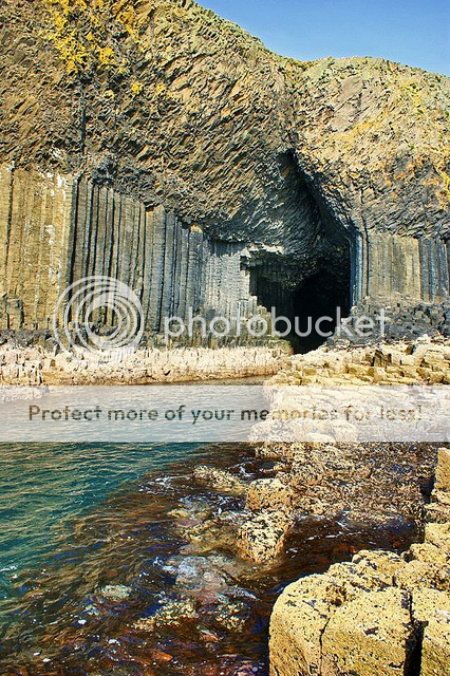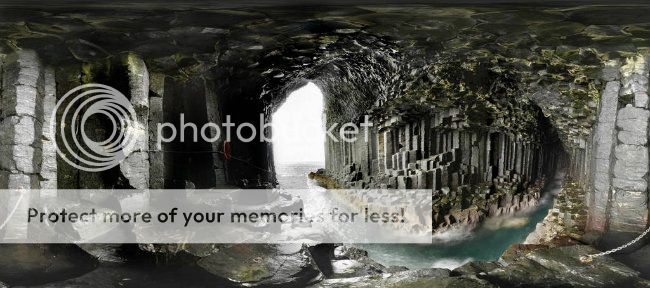-
*Astrella.
User deleted
Fingal's Cave - Scotland

Fingal's Cave is a sea cave on the uninhabited island of Staffa, in the Inner Hebrides of Scotland, part of a National Nature Reserve owned by the National Trust for Scotland. It became known as Fingal's Cave after the eponymous hero of an epic poem by 18th-century Scots poet-historian James Macpherson.
Formation
It is formed entirely from hexagonally jointed basalt columns within a Paleocene lava flow, similar in structure to the Giant's Causeway in Northern Ireland and those of nearby Ulva.
In all these cases, cooling on the upper and lower surfaces of the solidified lava resulted in contraction and fracturing, starting in a blocky tetragonal pattern and transitioning to a regular hexagonal fracture pattern with fractures perpendicular to the cooling surfaces.
As cooling continued these cracks gradually extended toward the centre of the flow, forming the long hexagonal columns we see in the wave-eroded cross-section today. Similar hexagonal fracture patterns are found in desiccation cracks in mud where contraction is due to loss of water instead of cooling.
Acoustics
Its size and naturally arched roof, and the eerie sounds produced by the echoes of waves, give it the atmosphere of a natural cathedral. The cave's Gaelic name, An Uaimh Bhinn, means "the melodious cave."
History
Little is known of the early history of Staffa, although the Swiss town of Stäfa on Lake Zurich was named after the island by a monk from nearby Iona. Part of the Ulva estate of the MacQuarries clan from an early date until 1777, the cave was brought to the attention of the English-speaking world by 18th-century naturalist Sir Joseph Banks in 1772.
It became known as Fingal's Cave after the eponymous hero of an epic poem by 18th-century Scots poet-historian James Macpherson. It formed part of his Ossian cycle of poems claimed to have been based on old Scottish Gaelic poems. In Irish mythology, the hero Fingal is known as Fionn mac Cumhaill, and it is suggested that Macpherson rendered the name as Fingal (meaning "white stranger") through a misapprehension of the name which in old Gaelic would appear as Finn. The legend of the Giant's Causeway has Fionn or Finn building the causeway between Ireland and Scotland.
The cave has a large arched entrance and is filled by the sea. Several local companies include a pass by the cave in sightseeing cruises from April to September. However, it is also possible to land elsewhere on the island and walk to the cave overland, where a row of fractured columns forms a walkway just above high-water level permitting exploration on foot. From the inside, the entrance seems to frame the island of Iona across the water.
In art and literature
Romantic composer Felix Mendelssohn visited in 1829 and wrote an overture, The Hebrides, Op. 26, (also known as Fingal's Cave overture), inspired by the weird echoes in the cave.
Mendelssohn's overture popularized the cave as a tourist destination.
Other famous 19th-century visitors included author Jules Verne who used it in his book Le Rayon vert (The Green Ray); poets William Wordsworth, John Keats, and Alfred, Lord Tennyson; and Romantic artist J. M. W. Turner, who painted "Staffa, Fingal's Cave" in 1832. Queen Victoria also made the trip.
The playwright August Strindberg also set scenes from his play A Dream Play in a place called "Fingal's Grotto." Scots novelist Sir Walter Scott described Fingal's Cave as "one of the most extraordinary places I ever beheld. It exceeded, in my mind, every description I had heard of it… composed entirely of basaltic pillars as high as the roof of a cathedral, and running deep into the rock, eternally swept by a deep and swelling sea, and paved, as it were, with ruddy marble, [it] baffles all description."
Artist Matthew Barney used the cave along with the Giant's Causeway for the opening and closing scenes of his art film, Cremaster 3. In 2008, the video artist Richard Ashrowan spent several days recording the interior of Fingal's Cave for an exhibition at the Foksal Gallery in Poland.
One of Pink Floyd's early songs bears this location's name. This instrumental was written for the film Zabriskie Point but not used.
Scottish Celtic rock band Wolfstone recorded an instrumental titled Fingal's Cave on their 1999 album Seven.
Dimensions
- Wood-Nuttall Encyclopaedia, 1907: 69 m (227 ft) deep, 20 m (66 ft) high.
- National Public Radio: 45 m (150 ft) deep; 22 m (72 ft) high.
- Show Caves of the World: 85 m (279 ft) deep; 23 m (75 ft) high.
Source: https://inovemondi.forumfree.it/?act=Post&CODE=00&f=11155274.
Fingal's Cave - Scotland12 Giugno 2014 |


